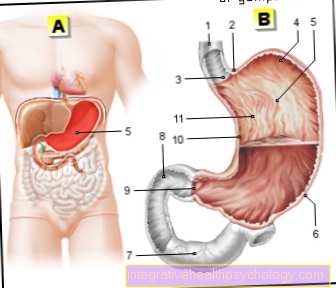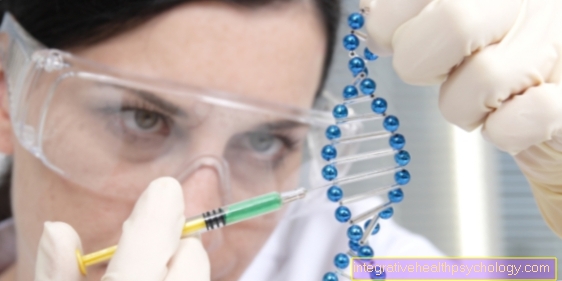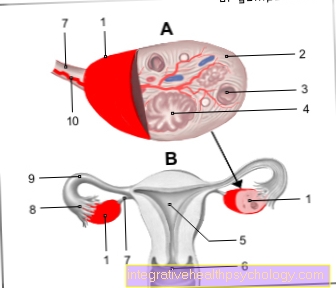Ovulation and temperature
introduction
The female cycle is designed to create all the necessary conditions for pregnancy in the first half and to enable fertilization through ovulation in order to be able to maintain a pregnancy in the second half.
The hormonal changes in the body not only lead to changes in the uterus and ovaries, but the rest of the body also adapts to a possible pregnancy. Women often notice this through mood changes or abdominal pain. But it also includes very small, mostly not subjectively perceptible temperature differences throughout the body. Since these temperature fluctuations are only 0.5º Celsius at the most, a very precise measurement to two places after the decimal point is important in order to be able to make a correct statement about the changes.

What is the temperature before ovulation?
Before ovulation, the temperature is slightly lower than after it.
The body is still preparing for pregnancy. For example, the lining of the uterus is built up further so that the egg can implant. During this period, the most important hormone regulating the cycle is estrogen. It also keeps body temperature at relatively low levels. These are different for every woman and depend on the individual lifestyle. They are on average around 36.5ºC.
Also read our topic: How can you induce ovulation?
What is the temperature during ovulation?
Before ovulation, estrogen drops in the first half of the cycle. This is perceived by the brain and the hormones that trigger ovulation are released. This also results in an increase in body temperature during ovulation.
This increase should create optimal conditions for the implantation of a fertilized egg cell and the beginning of pregnancy. If the temperature is higher on three consecutive days than on the previous six, it can be assumed that ovulation has occurred.
This topic could also be of interest to you: Can you feel ovulation?
What is the temperature after ovulation?
After ovulation, the temperature has risen by approximately 0.5º Celsius in relation to the time before ovulation.
The hormone that dominates the second part of the cycle is progesterone. It makes maintaining a pregnancy possible. If the egg has been fertilized, the progesterone and thus the body temperature will remain high. If the egg was not fertilized, the progesterone drops again at the end of the second half of the cycle, i.e. after 14 days. The decrease in progesterone also causes menstruation and the cycle starts again.
Also read: Can you postpone ovulation?
How Safe is the Temperature Method to Get Pregnant?
The certainty of getting pregnant with the temperature method differs from woman to woman and depends on the woman's physical and emotional requirements.
If all the prerequisites for pregnancy are met, the exact application of the temperature method increases the chances of becoming pregnant. In each cycle there are only 3-5 days on which sexual intercourse can lead to pregnancy. This is the time from the days before ovulation to the day after ovulation. To find out, the temperature method is very suitable and can make getting pregnant much easier.
Of course, the likelihood of an egg being fertilized depends not only on the optimal time of sexual intercourse, but also on other factors such as the man's sperm quality. It is important to know that even under optimal conditions and at the right time of sexual intercourse, the chance of ovulation is around 30%. This means that even under perfect circumstances, it can take a few months for pregnancy to occur.
Read more on the subject at: How to get pregnant - tips
How safe is the temperature method of contraception?
To indicate the safety of a method of contraception, the Pearl Index used. It says how many out of 100 women who have used a particular method of contraception will get pregnant in a year.
Using the temperature method alone is not very safe for contraception. Body temperature can be subject to fluctuations that are influenced by external factors. For example, mild colds, increased stress or a restless night sometimes cause the temperature values to rise slightly. For example, the time of ovulation is more often incorrectly determined if the temperature method is used alone. For this reason, the Pearl Index of the temperature method is between 1 and 3. In comparison, taking a pill has a Pearl Index of 0.1 to 0.9.
But there is the possibility of combining the temperature method with a method in which the change in the uterine mucus is determined, so that the safety of this method of contraception increases enormously. The Pearl Index of the symptothermal method is therefore between 0.4 and 2.3. It is therefore one of the very safe contraceptives. It is also important that the safety of any contraceptive always depends on how it is used. In the case of the temperature and symptothermal methods, this is strongly dependent on the experience of the woman using it. The safety therefore increases with prolonged use.
You can also read more information about detecting ovulation here: Knowing ovulation yourself
How high is the temperature rise during ovulation?
The rise in temperature during ovulation depends on the woman's initial values as well as on the physical condition on the day of ovulation.
Usually ovulation increases the temperature by 0.2 to 0.5 degrees Celsius. Since these are very low values, the temperature must be measured very precisely with a thermometer that shows at least two decimal places. Ovulation is usually on the day of the first higher value compared to at least six previous values. However, it can only be determined with certainty if the values are at least 0.2º Celsius higher than the initial values on the third following day.
You may also be interested in this topic: Fertile days
What are the alternatives to the temperature method?
There are some alternative methods of contraception besides the temperature method.
A similar and safer method of contraception is the symptothermal method. It is a combination of the temperature method with the so-called cervical mucus method. In addition to measuring the temperature, the mucus in the intimate area is observed and assessed. Since this changes in the course of the cycle and changes from whitish and tough to clear and watery shortly before ovulation, you can estimate the day of ovulation more precisely. As with the temperature method, assessing the mucus alone is far more uncertain.
Another well-known alternative is the so-called coitus interruptus, in which the penis is pulled out of the vagina before ejaculation. However, this method of contraception is very unsafe. The Pearl Index is between 4 and 30. Other safer alternatives are hormonal contraceptives, such as taking a pill or using an IUD. There is also the option of using copper or gold IUDs that do not contain hormones. The gynecologist can always be consulted about the choice of contraception method.
Read more on the subject at: prevention





























